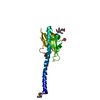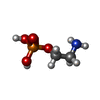+Search query
-Structure paper
| Title | Type IV pilus structure by cryo-electron microscopy and crystallography: implications for pilus assembly and functions. |
|---|---|
| Journal, issue, pages | Mol Cell, Vol. 23, Issue 5, Page 651-662, Year 2006 |
| Publish date | Sep 1, 2006 |
 Authors Authors | Lisa Craig / Niels Volkmann / Andrew S Arvai / Michael E Pique / Mark Yeager / Edward H Egelman / John A Tainer /  |
| PubMed Abstract | Type IV pili (T4P) are long, thin, flexible filaments on bacteria that undergo assembly-disassembly from inner membrane pilin subunits and exhibit astonishing multifunctionality. Neisseria ...Type IV pili (T4P) are long, thin, flexible filaments on bacteria that undergo assembly-disassembly from inner membrane pilin subunits and exhibit astonishing multifunctionality. Neisseria gonorrhoeae (gonococcal or GC) T4P are prototypic virulence factors and immune targets for increasingly antibiotic-resistant human pathogens, yet detailed structures are unavailable for any T4P. Here, we determined a detailed experimental GC-T4P structure by quantitative fitting of a 2.3 A full-length pilin crystal structure into a 12.5 A resolution native GC-T4P reconstruction solved by cryo-electron microscopy (cryo-EM) and iterative helical real space reconstruction. Spiraling three-helix bundles form the filament core, anchor the globular heads, and provide strength and flexibility. Protruding hypervariable loops and posttranslational modifications in the globular head shield conserved functional residues in pronounced grooves, creating a surprisingly corrugated pilus surface. These results clarify T4P multifunctionality and assembly-disassembly while suggesting unified assembly mechanisms for T4P, archaeal flagella, and type II secretion system filaments. |
 External links External links |  Mol Cell / Mol Cell /  PubMed:16949362 PubMed:16949362 |
| Methods | EM (helical sym.) / X-ray diffraction |
| Resolution | 2.3 - 12.5 Å |
| Structure data | EMDB-1236: Type IV pilus structure by cryo-electron microscopy and crystallography: implications for pilus assembly and functions.  PDB-2hi2: |
| Chemicals |  ChemComp-HTO:  ChemComp-OPE:  ChemComp-HOH: |
| Source |
|
 Keywords Keywords | CELL ADHESION / TYPE IV PILIN / FIBER-FORMING PROTEIN / membrane protein / DNA binding protein / contractile protein / TYPE IV PILI / virulence factors / natural transformation / antigenic variation |
 Movie
Movie Controller
Controller Structure viewers
Structure viewers About Yorodumi Papers
About Yorodumi Papers





 neisseria gonorrhoeae (bacteria)
neisseria gonorrhoeae (bacteria)